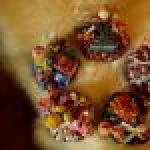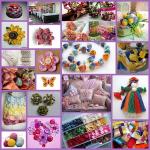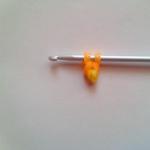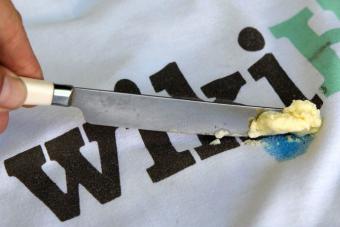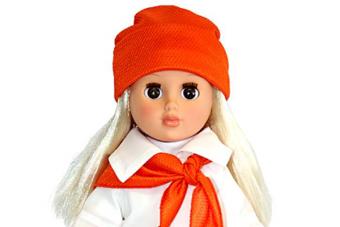Greetings lovers of needlework on the site Handmade stories!
Today I present a photo report on weaving a large round tray from newspaper tubes.
Part one: weaving a round bottom, the central part.
To weave a tray, I took office paper tubes, 16 pieces. They are not very long, but I will not build them up yet. I arrange them this way.
 Next, I connect two working tubes and begin to weave with a rope of two tubes, first I braid 4 tubes each, so 3 rows.
Next, I connect two working tubes and begin to weave with a rope of two tubes, first I braid 4 tubes each, so 3 rows.

Then I breed two tubes, in this case I wove 4 rows.

Now I breed one tube and weave 3 rows.

Part two: a rope of three tubes.
With a clothespin I mark the beginning of weaving.

The leftmost working tube passes over the two tubes of the base, then goes under the third base and goes up.

Those. I weave only with the leftmost tube. I continue weaving.

I close the row, for this I stop weaving in front of the first marked tube of the base and now I do not weave the extreme left, but the extreme right over the two main ones, behind the third. Further, the middle working tube, above the two main ones, behind the third. And in the conclusion of the extreme left, according to the same scheme. I hide the working tubes from the bottom of the tray and cut them off.
 Part three: the middle part with tubes of different colors.
Part three: the middle part with tubes of different colors.
Since in the previous row the working tubes closed the row and were cut off, I add new working tubes. One light, one dark. Weaving with a rope.


I close the central part again with a string of three tubes.
Part four: a rope of three tubes.


Tools and materials:
newspapers or promotional items made of thin paper;
spoke;
PVA glue, wood stain;
food colorings, interior varnish;
rubber gloves, scissors;
clothespins, plastic jar for the template.
How to weave a tray from newspaper tubes.
We cut paper rectangles of about 10x30 cm. We put the knitting needle on the paper blank at an angle of 45 degrees, tightly wind the paper and glue the corner. Carefully remove the needle. The number of tubes cannot be foreseen, and, if necessary, the required number can be modified.We will paint the finished tubes in the desired color. In this master class, wood stain is used for staining. Another option is to use food coloring to enhance the color palette.
When painting the tubes, we dip them into the paint for a couple of seconds, take them out on a newspaper or oilcloth and dry them well. You can dry it on a battery, or in natural conditions, it will certainly last longer. Also, it is worth recalling rubber gloves, without which you should not start painting.
 1
1
 2
2
 3
3
We make 16 prepared painted tubes 4x4 crosswise, additionally strengthen with PVA glue. This is the basis of the tray, in fact, the standing tubes, which we will braid with additional tubes.
 4
4
We fix two additional tubes with glue between the tubes at the intersection and begin to move in a figure eight, braiding 4 risers each (two rows). Next, we braid 2 risers (three rows).
If during operation one of the tubes ends, it can be increased. To do this, we take an additional tube and connect them with the ends, pushing the tip of the thicker tube thinner, you can additionally smear it with glue.
 5
5
 6
6
The next row is finishing. We carry it out with tubes of a different color.
 7
7
We knit another row with brown tubes, and the next 10 rows we will braid each riser. Since the diameter of the tray increases during operation, we need to increase the risers (through one).
In the course of work, if desired, we interweave light green finishing rows. We finish the work with a finishing edge in three tubes (for 2 risers under one). We cut off the excess.
 8
8
 9
9
 10
10
To make a stand for Easter eggs, we need 4 unpainted tubes, from which we weave a braid. We try on and fix the workpiece with clothespins to the template, which will serve as a plastic jar.
Cut off the excess and glue. When the glue is completely dry, the workpiece can be painted. Such coasters need 5-6 pieces. Attach them to the tray with PVA glue. We cover the finished tray with PVA glue diluted with water 1x1.
We give the product to dry completely, and then varnish and dry. We place Easter cake in the center of the tray, and Easter eggs will show off in the stands in a circle.
Newspaper tubes dyed in Brown color, are practically indistinguishable externally from wooden products. Newspaper weaving technique allows you to reuse unnecessary materials and also helps to save nature. The edges of such a little thing are made of various shapes, they are bent in different ways and form unusual patterns, using the achievements of experts in weaving baskets from a vine.
Features of working with newspaper tubes
The main difference between the technology of weaving trays from newspaper tubes and twigs is that working with wood materials requires a special attitude and certain knowledge. You need to be able to properly prepare them, process and store them. To bleach the vine and give it shape, you will need a lot of free space and sunlight - such conditions are difficult to provide in an ordinary apartment. Newspaper crafts look like wood but are much easier to make. No need to prepare the material for a long time - just cut the paper into strips of the desired length and width, twist them and paint them in the color you like.
newspaper articles
Products come in different shapes and sizes, they are created for a variety of purposes. On a wide Easter tray made of newspaper tubes, you can place Easter cake and eggs or present it as a gift to loved ones. A deep tray with handles is used to bring coffee to a loved one and wickerwork adds an ethnic touch to the interior and fills the space with comfort. In addition, this is an easy and economical way to make various beautiful containers for storing small items, decorating them to your taste.
Weaving options for beginners
For beginners who have recently learned about this technique, simple products are better suited. Variants of weaving from newspaper tubes for beginners, described step by step in simple language, most often relate to making vases or decorating bottles, because it is easier to shape the product. The hardest thing is to make the bottom of the craft. There are several ways to make it, but it will be easier for beginners to start by creating a basket, where you can use a regular basket as a frame. cardboard box. Their weaving from newspaper tubes for beginners is described step by step in various master classes. Having mastered the main ones, you can start creating a tray. Try to make a deep tray with handles with your own hands, in which you can place a cup of strong coffee with something sweet and bring it to your soulmate in the morning, giving her a charge of vivacity and good mood.

A tray of newspaper tubes: a master class
To work, you need to prepare:
- 2 sheets of thick cardboard
- clear acrylic lacquer
- water-based paint white color,
- gouache,
- water,
- pencil,
- brush,
- PVA glue,
- ruler,
- scissors,
- plain sheet A4,
- sharp utility knife
- knitting needle 35 cm long,
- a thick book or other object that can be used as a press,
- newspapers.
Start making the tray with a cardboard base: mark and cut out two rectangles measuring 15x20 cm. Place one of the shapes in the center of the A4 sheet and circle it to understand where to apply the glue. Then, using a brush, apply a thin layer of glue inside the rectangular base and place cardboard on top. Cut off the corners of the sheet with a ruler and a clerical knife. Apply glue to the edges of the paper and fold, pressing it firmly against the cardboard. Make another one of the same. Place both blanks for the bottom under the press until the glue dries.

Tube making
At the next stage of the “Tray of Newspaper Tubes” master class, you need to mark the bottoms with a pencil and a ruler, making marks on all sides at a distance of 2.5 cm. Now you need to make tubes from newspapers: a frame will be made from them. For work you will need newspapers, a clerical knife and a knitting needle.
- Cut a sheet of newspaper folded in half into 4 equal parts along the short side, and then divide the fold line. You should get strips about 5.5 cm wide. You will need 80-100 such strips. You can also use office paper to create a frame.
- Take one of the strips and apply a thin layer of glue to the long side. Twist the strip tightly onto the needle, starting at the opposite corner from where the glue was applied.
- Press the corner so that the tube does not unwind, remove the knitting needle and wait until the glue has completely dried. Make 30 pcs.
- Squeeze the sharp end of the tube and grease it on one side with glue.
Now glue the tubes along the marks to the bottom of the tray, pressing them well. Then, having filled the entire perimeter, apply glue to the bottom, carefully smearing the attachment points of the tubes. Attach another cardboard piece on top and place the blank under the press for at least six hours.
Tray assembly
The next step in the Newspaper Tray master class will be assembling the product. While the workpiece dries, make about 50 more tubes.
- Glue two newspaper tubes together lengthwise. Bend this part to get two equal parts, and start braiding the posts from the corner.
- Extend the tubes as needed and continue braiding the tray as you move around.
- At the end of the third row, fix, glue and cut the ends of the braiding tube.
- With a stand, grasp the next in a row and bend it up. Continue in a circle until you reach the last tube.
- Insert the last post of the row into the loop from below, formed by the first post, and bring it up.
- Start braiding the racks with a double tube from one of the corners. At the end of the fourth row, fix, glue and cut off the end of the braiding tube.
- Bend the post to the right, to the next post, and then lower it down. Cut off the end, retreating two centimeters from the fold, coat with glue and tuck into the weave from above.
- Continue in a circle.

Tray handles
Tray handles can be done as follows: insert two tubes covered with glue in the corners from the narrow side and bend two tubes towards each other, making a loop. Leave 5 cm from the fold and cut off the ends. Coat the edges with glue and insert into the base of the tray. Start wrapping the newspaper tube around the handle tightly. On the horizontal part, braid each two tubes separately with a figure of eight, then fix the ends with glue. Repeat all steps on the opposite side of the product.
Product design
It remains to prime and paint the tray in the color you like. For a primer, mix equal parts water, glue and white water-based paint, and then apply this composition with a brush to the entire surface of the product. Then add gouache to the primer and paint all surfaces except the bottom. Once the paint is dry, cover your creation with two coats of acrylic lacquer so it can be washed. The master class "Tray of newspaper tubes" is over. Use the product, delighting yourself and loved ones with a beautiful and practical thing made by yourself.
Dear masters!
There are a lot of workshops on weaving from newspapers on the Internet, but this topic is still relevant. That's why,
I am pleased to present my publication of a master class from newspapers in the magazine "Masteritsa" number 3, 2012 in the full author's version.
Materials and tools:
Old newspapers, or A4 paper, or window paper, one sheet of any color magazine
PVA glue
Glue "Titan" or "Master"
Acrylic paint in the following colors: white, baked milk, ultramarine, dark gold
Bamboo skewer with a diameter of 2.5-3.0 mm
Flat synthetic brush, 4-5 cm wide
Fan brush, synthetic
Napkins with a pattern, you can use 3-ply or 2-ply
Any hairspray
One file (usually used for documents)
Iron
Acrylic water-based varnish brand "MAV", or "Eurotex" or any other
Lacquer "Tsapon", used for finishing coating, withstands high temperatures
A piece of textured wallpaper (you can use leftovers after repair
Corrugated cardboard
Mini drill or awl
Scissors
Clothespins
Progress:
First, we will make tubes - this will be our “vine”, for this we cut off strips 7-8 cm wide from the newspaper, from the side where there is a white edge.
We hold a newspaper strip with our left hand, put a wooden skewer on it at an angle of 45 degrees from the side of the letters, an unpainted strip remains on the right side. We begin to tightly wind the newspaper onto a wooden skewer, when we twist the tube almost to the end, apply a little PVA glue to the remaining free tip, scroll the tube to the end. Thus, the tip of the newspaper will stick. The tube is ready, and note that we got it in white, all the letters remained inside. 
Pay special attention to how you twist the tubes, how neat and tight they turn out, as this is very important at the first stage of manufacturing. The final appearance of your product also depends on the quality of twisting. The thickness of the wooden skewer also matters. The thinner the skewer, the thinner the tube.
Next, prepare corrugated cardboard- this will be the bottom of our tray, we cut out 2 identical parts 36x24 cm in size with scissors, but you can make a tray according to your own sizes.
On one part, we mark points for future holes for the main racks of the tray. This is an even number, in our mk 40 racks.
To do this, we calculate the distance between the posts so that it is 2.5-3 cm. I can note that from my weaving practice, this is a more acceptable distance for a dense and durable woven fabric. It is necessary to retreat 0.6-0.7 mm from the edge of the part. After marking, we take a mini-drill (you can use the Dremel engraver) and make holes in the marked places 
The second detail of the future bottom remains unchanged. For racks, I use short tubes.
Short racks are placed in the holes made.

Next, apply Titanium glue to the ends of the racks, press it against the cardboard bottom and secure with a clothespin.
So nothing will shift, you can dry it on a flat surface. When the racks are glued, apply PVA glue to the surface of the cardboard bottom and press the second part tightly, you can also use clothespins. So, we should get a mini "sandwich". The ends of the short posts should remain inside and are not visible. Dry again on a flat surface, you can use any weight that we place on top of the mini "sandwich" of the bottom. The hitch in this case will be much better. Dry for at least 12 hours.

When the drying process is completed, cut out the same two parts from the textured wallpaper, in our case, the paper wallpaper left after the repair. The size of the parts should match the bottom of our product 36X24 cm. You can glue two parts at once on PVA glue, we will also use clothespins (along the edge of the bottom). Sushi


While the paint is drying, we will make an interesting finish for future tray handles.

To do this, take any sheet from a colorful bright glossy magazine, mark it into triangles, where one side will be 3 cm, and the opposite side will disappear in the center, cut it with scissors and twist the beads from the resulting triangles. We will pick up something with a pen, pencil, etc. in thickness so that later we can put the bead on the stand.
We wind our triangle on a round object from a wide cut to a narrow one, glue the tip with PVA glue. We dry. Very nice beads came out. The longer the paper triangles are, the "bulkier" the beads will be.
Now you need to prepare a napkin for decoupage of the bottom of the tray. Carefully separate all the light layers of the napkin from the colored layer. We put a napkin on an ironing board, spray it with hairspray and iron it through white paper with a hot iron. So do 2-3 times. Thus, an invisible film is formed on the colored layer of the napkin, the napkin will become much stronger and more elastic. You will be able to carefully glue the motif to the product.

In this case, we will prepare two identical napkins from which we will tear out motifs with our hands.
We will glue motifs to the surface of the future bottom using the “file method”.

Since we will be doing direct decoupage, put the torn-out motif with the FRONT SIDE on the file! The next step is to carefully pour water onto the file, you can simply “by hand”. Pour enough water so that the napkin gets wet and floats a little in a puddle of water. We straighten the fragment of the napkin, due to the fact that it is in water and prepared in a special way, the motif does not tear, it stretches a little and it can be easily leveled over the file. Shake off excess water. We outline visually where this fragment will be located.
We attach the file with the motive to the product, lightly stroke the file with our hands, expelling excess water and air bubbles. We make sure that everything is perfect and carefully remove the file, the fragment itself remains on the product.

Then we take a fan brush and diluted PVA glue (1: 1) with water, coat the motif. Sushi


Let's do the same with other fragments.
Since the texture of the wallpaper with a convex pattern, then decoupage on an uneven surface gives an interesting "zest".
Then we take two long tubes, and glue them to any main small tray stand. The main rack should be in the middle, between the tubes. It turned out 2 additional tubes, so we will weave them with a “rope” (see the “rope” diagram). The first row of weaving should be as close as possible to the base of the bottom to hide any irregularities. 


Use clothespins again, pinch your weave in different places, then the product will be even.
After the first row, you need to raise the small racks vertically. It is advisable to choose some kind of basis on which you will weave. It could be a box, or a big book. Then your product will have an even weave and a beautiful look. We also constantly build up our tubes (vine), with which we weave. To do this, cut off the ends of the tubes a little, insert the thinner tip a little by scrolling into the wider


Everything should look neat, the place where the tubes are built up should be hardly noticeable. Usually you need to “screw in” until you feel that everything has grown together firmly. If this did not happen, then drop a drop of Titan or Moment glue into the place of extension. This glue dries quickly and paper does not get wet.

When 4 full rows have been woven, put the prepared beads on vertical racks



We bring the vertical racks out, start the 1st rack for the 2nd, the 2nd rack for the 3rd and so on. Look carefully at the photo, you can see everything there. When the 1st row of closing ends, we wind the last tube through the 1st tube outward


Now we will bend the tubes inside the product



The photo shows what happens in the end.
Next, we cut off all the extra tails of the vertical racks, while liberally lubricating all surfaces and joints with PVA glue, fasten everything with clothespins and dry for a day until completely dry. 
Now it remains to talk about the decor. Of course, you noticed that the beads are almost red-yellow-white. This does not harmonize with our "grapes".
Therefore, we take acrylic paint ultramarine color and paint over our beads. They become a heterogeneous blue-violet hue - this is very suitable for our "grapes". Next look, newsprint has an unsightly gray shade, this can be fixed too. We take acrylic paint of the color of baked milk, dilute it to the density of liquid sour cream, and carefully paint over our product from all sides. We also paint a little with the same paint between the motifs, since there are white gaps there. If necessary, after drying, repeat the painting. Dry again. We make sure that everything suits us, that all the places of weaving are dyed, that the color of the braid is uniform.
Now we will decorate the place where the tray closes. Firstly, this can hide the shortcomings of our weaving (if any), and secondly, this will achieve completeness in the design of the tray. Let's take some ultramarine paint (do not dilute it with water!) A piece of a large-pored sponge (you can use a sponge as for washing dishes). Dip the sponge a little into the paint, then press the palette several times, this will get rid of excess paint from the sponge. And then gently tampuem the contour of the tray. The paint lays down on the bulges of weaving and the effect of frost is obtained. We look critically at our product and add a little acrylic dark gold paint using the same “tamping” method. We pass a little through the leaves, grapes, the background of the bottom of the braid. We will also add some acrylic gold paint over the beads and the edging of the tray. Now our product has played in all its glory!
Now it remains to consolidate our result. We take any water-based acrylic varnish (it is odorless), cover our tray 2 times, with an intermediate drying of 2 hours.
Since the tray will be used frequently, the protective coating must be resistant and durable. The finishing varnish "Tsapon" will help us with this, this varnish can withstand various temperature changes, including high ones.
When using this varnish, take safety measures, you must turn on the hood or open a window to vent harmful fumes. The varnish dries very quickly, does not turn yellow, the smell is not very strong. Brush after use, rinse several times in running water with soap, this will be enough.

And now we admire our product and plan what we will weave next time. After all, paper weaving will give you pleasure, and you can also make many useful and necessary things in your cozy home.
We all learn from each other, maybe my experience will help you find answers to your questions.
I do not pretend to be exclusive, there are masters to whom I am very far away, to study and study.
I will be glad to comments)))))))
Newspaper tubes are an affordable and functional material for creativity, which is easy and pleasant to work with. Today we will tell you about another accessory that can be made from them. In this article, you will learn how to weave a round tray for your home from newspaper tubes. This is a simple master class that even beginners can handle.
Earlier we told you what can be made from newspaper tubes. It was about baskets and even houses for cats. Today we will go a little beyond the usual framework and talk about the creation of an accessory, looking at which you would not think that an ordinary newspaper has become the basis for its manufacture.
What will we need?
- newspaper
- paints
- craft varnish (non-toxic)
If you don't know how to make newspaper tubes, take a look at where we go into detail about this technique. Prepare long straws - the number depends on how large you need a tray.
How to weave a tray?
Take the first 20 tubes and fold them crosswise in 10 pieces. Next, take the next tube and fold it in half. Intercept her tubes that lie on top.

Weave the ends, and then bring the bottom one up, and the top one down. Go around the bottom layer of ten newspaper tubes on both sides and twist the ends again.
Repeat the procedure with the next side face. We do this until our newspaper tube runs out.

When the newspaper tube ends, we interweave a new one. Well, the central tubes need to gradually continue to split.

When you have woven the desired size of the tray, you need to start lifting the protruding tubes (central) up. To do this, we need to intertwine them with each other - adjacent to the adjacent.
Then we braid them as usual with the help of three or four additional newspaper tubes. Next, we complete the product with a pigtail. To do this, we need to twist the tubes sticking up in the same way - adjacent to adjacent ones (two each). The remaining ends must be hidden down.
 Views: 955
Views: 955

